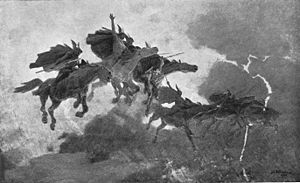In an age when the role of the warrior was key to protecting one’s family as well as to carving your own path in the world, the process of becoming a warrior was a central part of a youth’s life. Certainly this was so for boys and even (although to a far lesser extent) to some girls, as we shall see.
Learning to be warriors
It appears that the Anglo Saxons saw the age of 7 or 8 as the beginnings of the journey to adulthood. One piece of evidence for this is the writing of Bede who, when talking about the future St Cuthbert, noted that his calling to God’s service happened at this time when he was engaged in childhood games with his friends. Furthermore in the Anglo Saxon saga ‘Beowulf’ the future great warrior is taken from his father to the service of his lord at the age of seven.
Training
For boys then military training would began at around the age of 8. They would train using mock wooden weapons and wicker shields. We know this because sometimes there are references to youths training with them in writings and occasionally small wooden weapons survive in the graves of children.
Some of the skills which were needed for battle would have to be specifically taught. Some would come naturally through other activities such as wrestling (a widely reported childhood activity by Bede and others) and hunting animals such as boar. There is some evidence that hunting was at times ritualistic and became part of the initiation of youths into manhood. Caesar records that Germanic youths would hunt down aurochs (huge wild cattle native to the forests of Germania) and try to slay them single handily.
Training is hinted at in numerous writings such as the account of the Battle of Maldon where a leader passes through the ranks instructing men where to stand and reminding them of how to hold shields and wield weapons. There were many skills to learn. Forming and reforming a shield wall would take practice, as would advancing as one body in such a way that the  shieldwall would not fall apart or gaps appear between the shields. The correct use and roles of swords, spears, axes and missile weapons is not something that would just be known – men would teach youths and pass on the knowledge.
By about the age of 14 a choice would be made if the boy wanted to be a warrior and at this age he would probably be given the family sword if there was one. Certainly youths of this age fought (and died) in battle as evidenced by mass graves and by the chronicles recording the early years of Anglo Saxon Saints.
Warrior bands and associations
There is some evidence of what amounted to something approximating to clubs/bands/associations of warrior youths. Certainly some writings of the Norse period had groups of youths who would forgo armour and hunt wolves or bears and cloth themselves in their fur and go around in groups with others wearing the same garb. These warrior bands may have also existed in the Anglo Saxon period as well, although there is less evidence. Given the natural appeal of ‘belonging’ to a tribe that applies to teenagers today one can readily imagine the attraction of being one of the band.
Shield Maidens and Women as warriors

Whilst military pursuits were predominantly male there is evidence of a small number of women who took part. Firstly there are legends and stories such as those of the Valkyries – female warrior servants of the gods who rode into battle armed and armoured and then chose who lived and died and took the slain back to the halls of the gods. In the circa 7th century saga of Judith there is a reference to a woman carrying a sharp sword. In the early German tales of Nibelungenlied we read of Princess Kreimhild taking vengeance with an axe for the death of her husband.
So much for legend, what about archaeology? Well there have been cases of graves of women containing both weapons and female items (like spinning equipment). Were these the graves of fallen shield maidens?
So then learning to be warriors was time consuming but critical part of a youth’s life and central to their culture and world view. IN future blogs I will look at Weapons and Armour and also Military Organisation in the Anglo Saxon time.
Much of the material here is taken from The English Warrior by Stephen Pollington or Warriors of the Dark Ages by Jennifer Laing.
This coming of age and learning to be a warrior is a central theme in The Amber Treasure, my Dark Age historical Fiction novel which follows Cerdic and his friends as they learn about and then experience war first hand.



Related Articles
No user responded in this post